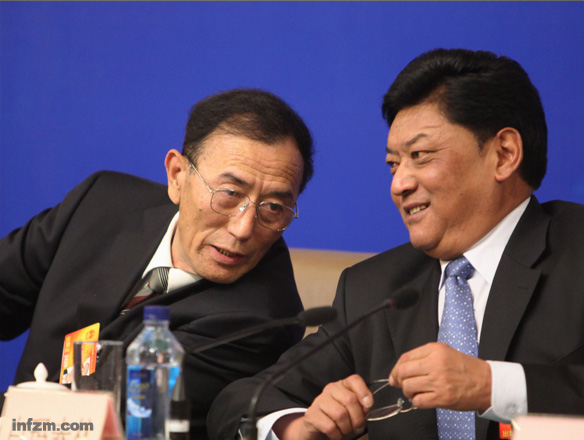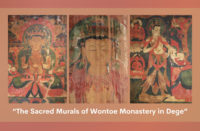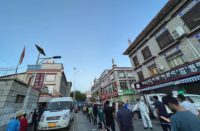High Peaks Pure Earth has translated a blogpost by Woeser written on April 5, 2012 for the Tibetan service of Radio Free Asia and posted on her blog on April 17, 2012.


March is a sensitive month for Tibetans because it is full of days that mark important and emotional historical changes since March 10, 1959. March is also a sensitive month for China, the fantastic drama of the so-called “Liang Hui” (Meeting of the National People’s Congress and Chinese People’s Political Consultative Congress) takes place once a year in this month. A cartoonist who mocks the autocracy, caricatured those in power by drawing them with particularly long noses; we all know that this is a symbol for liars.
At this fantastic drama, representatives from “national minority groups” and “religious organisations” are indispensable figures, all acting as decorative “pretty vases”. That is why on TV and in newspapers we see the colourful and bright members of “national minority groups” and “religious organisations” decorating the scenery of the flourishing empire. The very same kind of scenery already existed in the former Soviet Union.
Some “minority” representatives had, however, changed into fashionable suits and shiny leather shoes, also wearing sophisticated looking glasses, which were to demonstrate that they kept up with recent trends, but whatever these people said it was wrong; wrong to an extremely vulgar extent, that they became a laughing-stock.
Especially noteworthy is the interview that the slightly less government oriented “Southern Weekend” carried out with two “Liang Hui” representatives: Jampa Phuntsog, Chairman of the Standing Committee of the People’s Congress of the Tibet Autonomous Region and Pema Thinley, the head of the Tibetan Autonomous Region. The increasingly government friendly Hong Kong TV station, Phoenix, also interviewed Jampa Phuntsog.
Even though the reports all appeared after the “Liang Hui” had finished, they were typical for the meeting and full of lies.
For example, Jampa Phuntsog said, “In 2012, working teams are stationed in 5000 administrative villages. This is not just to maintain stability, it is more about helping local residents to foster economic development. The cadre stationed in the village will change once a year, and within the next three years, the entire region will have had over 20,000 different cadres stationed in villages.”
Another example from Jampa Phuntsog said, “Leaders from the central authorities explained to me that stability stood above everything. Now, we are putting into practice the conventional and unconventional measures to maintain stability. The so-called conventional measures are referring to the work carried out by offices and departments belonging to the government; unconventional measures are put into practice during sensitive times, when special control schemes will have to be implemented, including controlling the streets.”
And an example from Pema Thinley who stated, “Jiuzhaigou has several million tourists every year, are they destroying Jiuzhaigou? Tibet covers 1.2 million square kilometres of land, in 2011, only just over 6 million people came into Tibet, are they really destroying the ecology?”
These statements don’t require further analysis, I just wanted to note them here and let people make sense of them for themselves.
Above all, Jampa Phuntsog said: “Giving out portraits of leaders is distinctive to Tibet and has a long history and tradition… in Tibetan Buddhism, many Bodhisattvas are actually real people, for example Siddhartha Guatama, Tsongkhapa, Songtsen Gompo, Princess Wencheng were all regarded as objects of worship… thus, giving out portraits of leaders is by no means strange, it is totally natural and is well-received by nuns and monks… whether they put them up or not is up to them, they are not forced to.”
As soon as these words had been spoken, they caused immediate uproar. In fact, this passage serves as a perfect example for a study on the relationship between centralised political power and religion.
The Han Chinese scholar He Qinglian who resides in the US writes in a recently published article: “The relationship between the political culture of the central government and religion has always been characterised by an inherent tension. The way that the CCP uses political force to solve religious problems is inappropriate. This will only lead to mounting tensions between the CCP and various different religious schools, it will result in an inherently tense relationship between central politics and religion and it will end in contradictions and quarrels between the government and religious groups intensifying by the day. I can predict that the clashes between politics and religion in China will in the future become the main aspect among all sorts of collisions and discrepancies that are happening in Chinese society.”
Actually, telling lies requires courage, it requires the courage to sell out one’s conscience. I dedicate a special poem to this kind of courage:
“His blood-red eyes / His unsteady expression / His grin / The false smile on his face / The hand that has fired guns / The hand he hides away / That’s right, I am talking about these two people / One is Pema Thinley / One is Jampa Phuntsog”
April 5, 2012





Follow Us!